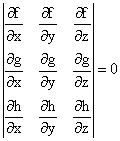|
|
||
|
|
||
|
Suppose we want to find the minimum value of a function f (x, y), subject to
the condition, g (x, y) = 0.For this minimum to occur at the point p, p = (x',y'),
p must obey that condition, and ![]() f
and
f
and ![]() g
must have the same direction at p
g
must have the same direction at p
The directions normal to![]() g
lie in the tangent plane to the surface at p. If f has a non-vanishing directional
derivative in this plane it can't have a critical point in the surface. Thus
for f to be critical in the surface at p,
g
lie in the tangent plane to the surface at p. If f has a non-vanishing directional
derivative in this plane it can't have a critical point in the surface. Thus
for f to be critical in the surface at p,![]() f
must be normal to the tangent plane; which means that
f
must be normal to the tangent plane; which means that![]() f
and grad g have the same direction, up to sign.
f
and grad g have the same direction, up to sign.
This condition means that the parallelopiped defined by the vectors ![]() f
and
f
and ![]() g
has no area, which means that the determinant equation holds:
g
has no area, which means that the determinant equation holds:

which means
![]()
The two conditions, g = 0, and this cross partial identity, are very easy to apply; they determine the critical points of the surface.
This method and its generalizations to higher dimensions, are called the method of Lagrange Multipliers, since it was invented by Lagrange.
The condition that ![]() f
and
f
and ![]() g
are parallel can be written as
g
are parallel can be written as
![]() f
=
f
= ![]()
![]() g,
or explicitly as
g,
or explicitly as
![]()
Here![]() is called the Lagrange multiplier.
is called the Lagrange multiplier.
(Note: For some unknown reason, students are rarely taught to multiply the
left of the first equation with the right of the second and equate with the
opposite, which gives the cross partial condition we have discussed. They are
instead told only to solve the three equations consisting of g = 0 and the two
involving![]() .
The first step in this process is always to eliminate
.
The first step in this process is always to eliminate![]() by
cross multiplying.)
by
cross multiplying.)
Suppose we face the same problem in 3 dimensions: to find critical points for
f given g = 0 (which defines a surface.)
Everything said in two dimensions holds in 3 as well. The critical condition
is still that ![]() f
and
f
and ![]() g
are parallel. This means that the cross partial conditions hold for all three
sets of variable pairs (y, z) and (z, x) as well as for (x, y). In terms of
Lagrange multipliers, we get an additional third equation involving
g
are parallel. This means that the cross partial conditions hold for all three
sets of variable pairs (y, z) and (z, x) as well as for (x, y). In terms of
Lagrange multipliers, we get an additional third equation involving ![]() :
:
![]()
Suppose we are constrained to move on a curve in 3 dimensions: we want to find
critical points for f given g = 0 and h = 0.
The condition we want to impose is that ![]() f
has no component tangent to the curve, which means that
f
has no component tangent to the curve, which means that ![]() f
lies in the plane of
f
lies in the plane of ![]() g
and
g
and ![]() h.
h.
This means:
1. that the volume of the parallelopiped formed by the three gradients here is 0. This is a three dimensional determinental condition analogous to the cross partial condition but uglier:

2. that ![]() f
can be written as
f
can be written as![]() 1
1![]() g
+
g
+ ![]() 2
2![]() h.
This statements amounts to three equations, one for each vector component, with
two new unknowns,
h.
This statements amounts to three equations, one for each vector component, with
two new unknowns,![]() 1
and
1
and ![]() 2.
Their solution leads to the determinental equation just given.
2.
Their solution leads to the determinental equation just given.